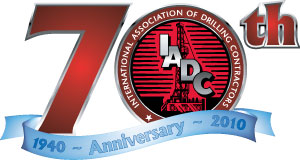70th Anniversary Retrospective
IADC celebrates its 70th anniversary in 2010. In recognition of this milestone, and in anticipation of the decades ahead, DC is publishing a retrospective from issues of decades past. We invite you to explore the the historical contrasts and similarities that may emerge and chart the industry’s evolution through these episodic vignettes. The past is written, and has brought us to 2010. But who knows what the future may hold?
Rotating control device spec adopted by API
Jan/Feb 2005
For the first time, a manufacturing specification drafted entirely by an IADC committee has been adopted by the American Petroleum Institute (API). The new document, designated API Specification 16RCD, covers the manufacture of rotating control devices used in underbalanced operations and managed pressure drilling. The document was expected to be in print by the end of 2004.
A Task Group formed under the auspices of the IADC Underbalanced Operations Committee was responsible for the work. The group, chaired by John Ramalho, Shell International E&P, comprised drilling contractors, manufacturers and producers members.
“This achievement demonstrates a new level of participation in the development of international standards,” said IADC President Dr Lee Hunt. “We are grateful to API for recognizing the importance of the document and for acting quickly to adopt it.”
UBO Committee Chairman Mike DuBose, Rowan Drilling UK Ltd, also acknowledged the Task Group’s accomplishment: “(The group) worked diligently for more than two years to deliver this much-needed standard,” he said. “The individuals and companies involved are to be commended.”
IADC Brazil Chapt: Helping poor
children help themselves
Jan 1995
The IADC Brazil Chapter is literally providing the mortar, bricks and sustenance to help poor children build better lives—along with toys to let some “fun shine” into often hardscrabble lives. The Chapter is working with 4 child-oriented charities in Macaé and has garnered enthusiastic support from the people at member companies.
“The IADC Brazil Chapter has recognized the need to support the community in which we work and live,” explained Chapter Chairman Dave Keating of Wilrig. “To this end, the members identified 4 charities in Macaé which IADC is assisting.” The chapter made initial contributions, later enhanced by support from the people at member companies.
2 are day-care facilities for poor children. The Chapter donated milk, biscuits and meat to the Creche Jesus de Nazareth, directed by Sister Maria de Lourdes with assistance from volunteer couples. The non-profit day care tends daily to about 80 children aged one to 7, providing 4 meals per day. The children mostly live in single-parent households, their mothers working as maids to support the family. Creche Jesus also offers a medical and dental office to attend the children and their relatives.
“We now have the capability to drill in 8,000 ft of water”
May 1980
Sedco continues to expand in two areas, according to the company’s Technical Vice President Dillard Hammett. “We are expanding,” he says, “to drill in deeper and more hostile ocean environments while at the same time keeping very active exploring for petroleum resources in historical oil provinces” (Gulf of Mexico, West Africa, Arabian Gulf, and Indonesia).
In recent years, recalls Hammett, “we have expanded into deep water exploration using dynamically positioned drilling vessels.” A result of this expansion was the SEDCO 709 semi, the unit that last year drilled 4,000 ft of water off easter Canada, where 40-ft waves are a common occurrence.
The most recent expansion of SEDCO has been into the jackup category. Since mid-1979, the firm has purchased seven units of this type. Three of them will go into services in 1980 and the remaining four will become operational by mid-1981. SEDCO now owns and operates 21 semis, 9 jackups, 3 drillships, and 2 platform rigs.
“When we first moved offshore in the early 1950’s,” says Hammett, “we were learning. Since then we have continued moving further offshore—and by now we have been confronted by, and successfully drilled in, almost every environment winds, waves, currents, ice, and tides could subject us to.”
To prove the above statement, Hammett waves some impressive statistics. Company units, he discloses, have operated successfully under the following conditions:
• Stay on location in 100 mph winds
• Continue drilling in 40 ft waves and survive 100 ft waves
• Stay connected and drill in 4 knot current
• Safely drill in area of icebergs and ice floes
• Drill in 30 ft tidal range
• Drill in 5,000 ft water depth
“One example of our steady progress in offshore environments,” explains Hammett, “is the water depths in which we have drilled. The company has moved all the way from 100 to 5,000 ft of water. And we now have the capability of drilling in 8,000 ft of water.”
Contract Form Revised
April/May 1960
Several revisions have been made in the Rotary Drilling Contract form, under the direction of the AAODC Contract Committee. The task of rewriting the contract involved almost three years of the committee’s work. The Contract Committee started as a special committee appointed by the president of the Association. Its work is now considered of such importance to the drilling industry that the Contract Committee is now a standing committee which has been given the responsibility of a continuing study for the betterment of contractual relations between owners and contractors.
Unprecedented petroleum demand continues upward
February 1945
A study of current unprecedented winter demand for petroleum product tells an interesting story. With most of the 30,000,000 American automobiles and trucks on a reduced gasoline ration, war demand has much more than offset the deficit. Even the petroleum industry itself could not predict such a sustained demand for its products at the war’s beginning, because the magnitude of the war was not fully foreseen.
The production of domestic crude oil during 1944 is estimated by the Bureau of Mines at 1,678,000,000 barrels, an increase of 11 per cent over 1943 production. However, the demand for domestic crude petroleum for 1944 is estimated at 1,700v,000,000 barrels, indicating a decline in stocks of 22,000,000 barrels during the past year. The daily average demand rose from 4,478,000 in the third quarter and to 4,623,000 in the second quarter, to around 4,740,000 barrels daily in the fourth quarter. The forecast for the first quarter of 1945 indicates a demand for domestic crude petroleum of about 4,730,000 barrels, assuming a moderate decline in production and a corresponding reduction in stocks of domestic origin, the Bureau states.
Other estimates for 1944 are interesting. The total demand for motor fuel for last year was about 738,000,000 barrels, a gain of nearly 19 per cent over 1943. Thus the demand for straight motor fuel was greater in 1944 than the entire production of domestic crude oil in any year prior to 1925. The yield of gasoline from crude oil was about 39.4 per cent, as compared with a yield of 37.1 per cent in 1943. The gain in demand for motor fuel was the outstanding factor in the demand for refined products in 1944, as the combined total demand for residual and distillate fuel oils will show an estimated increase of only around nine per cent over 1943.
The indicated demand for motor fuel in January, 1945, was 61,000,000 barrels, an increase of 15 per cent over January 1944. January 1945, demand for domestic crude petroleum was 146,900,000 barrels, or 4,738,700 barrels daily.
The quality and quantity of crude oils refined affect the average gasoline recovery per barrel, but for the resent the indicated recovery is around 39 per cent.






